
Regarding the 3D printing shell with integrated heat exchange function, I have previously shared a gearbox developed by GE, which is a shell with multiple cavities. A heat exchanger is additionally manufactured in a plurality of walls in the chamber, and such a heat exchanger includes a plurality of heat exchange channels. Recently, United Technologies Corporation-UTC’s patent for 3D printing a lightweight housing with integrated heat exchange function was approved. This UTC patent provides a method for producing lightweight, low-cost components.
Integrated structure, 3D printing opens a new component era
It should be said that it is impossible to carry out CNC subtractive processing to achieve such a design after the traditional casting is completed. UTC was originally aimed at using a combination of subtractive manufacturing and additive manufacturing to manufacture lightweight housings with integrated heat exchange functions, effectively realizing the combination of complexity and precision.
UTC applies an open-cell foam structure to the design of the heat exchange function to allow the passage of the second fluid. The porosity of the foam structure can be in the range of 5% to 80%. The choice of porosity can depend on the part to be formed. End use. Compared with the original traditional manufacturing process, this design can be completed faster and at a lower cost than machining solid material blocks. Compared with the mechanical processing applied to solid blocks, the waste of raw materials is significantly reduced. In addition, the thickness of the metal deposit (or ceramic deposit) outside the foam structure can be adjusted to achieve the required strength.
This design provides a low-cost, lightweight option for machined parts used in valve bodies and other applications. Compared with blocks of solid blank material, additively manufactured parts require fewer raw materials. In order to enrich the internal features and realize more complex functions, one or more components are also integrated into the structure, and this structure can avoid the risk of fluid leakage, and the connection of the components and the required structural functions are provided through the metal shell.
Review
In the context of the functional realization-oriented product design concept brought by 3D printing, integration is a trend. Take gas turbine engine components as an example. Generally, conventional heat exchangers used in gas turbine engines are positioned in gas turbine engines. “Brick” block structure at various locations inside. These heat exchangers are like outdoor units of air conditioners, connecting heat exchange areas through one or more fluid circulation pipes. In the past, the heat exchanger of the gas turbine engine was far away from the accessory gearbox and required oil to be supplied to the heat exchanger through a separate fluid circulation pipeline. Each pipeline requires additional component storage, and brings additional assembly and cost. In addition, the possibility of leakage increases, and when the fluid is transferred to a heat exchanger located at a remote location, the fluid may lose a large amount of heat energy.
Therefore, it is promising to improve the heat exchanger used to cool the gearbox. More specifically, the heat exchanger used in the gas turbine engine requires less space, is easier to assemble and install, and needs to reduce fluid leakage and Possibility of heat loss. Through 3D printing, not only can the gearbox and heat exchanger be manufactured in an integrated structure, but also very thin wall thickness can be achieved. In this regard, 3D Science Valley once shared the integrated gear with integrated heat exchanger developed by GE The box concept can be similarly applied to various gearboxes, such as transmission gearboxes, power gearboxes, reduction gearboxes, or other parts of turbofans. It can be applied to automotive, aviation, maritime and other fields.
Heat exchangers are undergoing changes, and the next generation of heat exchangers and radiators is coming. Such as the lightweight housing with integrated heat exchange function and the integrated gearbox with integrated heat exchanger have the potential to subvert in many aspects, avoiding the need for additional accommodation space in the gas turbine engine for remote positioning of traditional heat exchange modules. In addition, hidden dangers such as leakage are avoided. In the past, fluids had to circulate through separate fluid circulation pipes, and these pipes had to be assembled with seals, bolts, nuts, etc. Also, each pipeline requires additional component storage, assembly and cost. In addition, in previous designs, when the fluid is transferred to a heat exchanger located at a remote location, the fluid may lose a large amount of heat energy.
In addition, through the 3D printing process, a specific surface finish and channel size can be formed to improve fluid flow through the channel, improve heat transfer in the channel, and so on. A rougher finish can be achieved by increasing the laser scanning speed or the thickness of the powder layer, and a smoother finish can be achieved by reducing the laser scanning speed or the thickness of the powder layer. You can also change the scan path or laser power to change the surface finish of a specific area. It is worth noting that a smoother surface can promote faster fluid flow through the heat exchanger channels, while a rougher surface can promote fluid turbulence and increase heat transfer.





